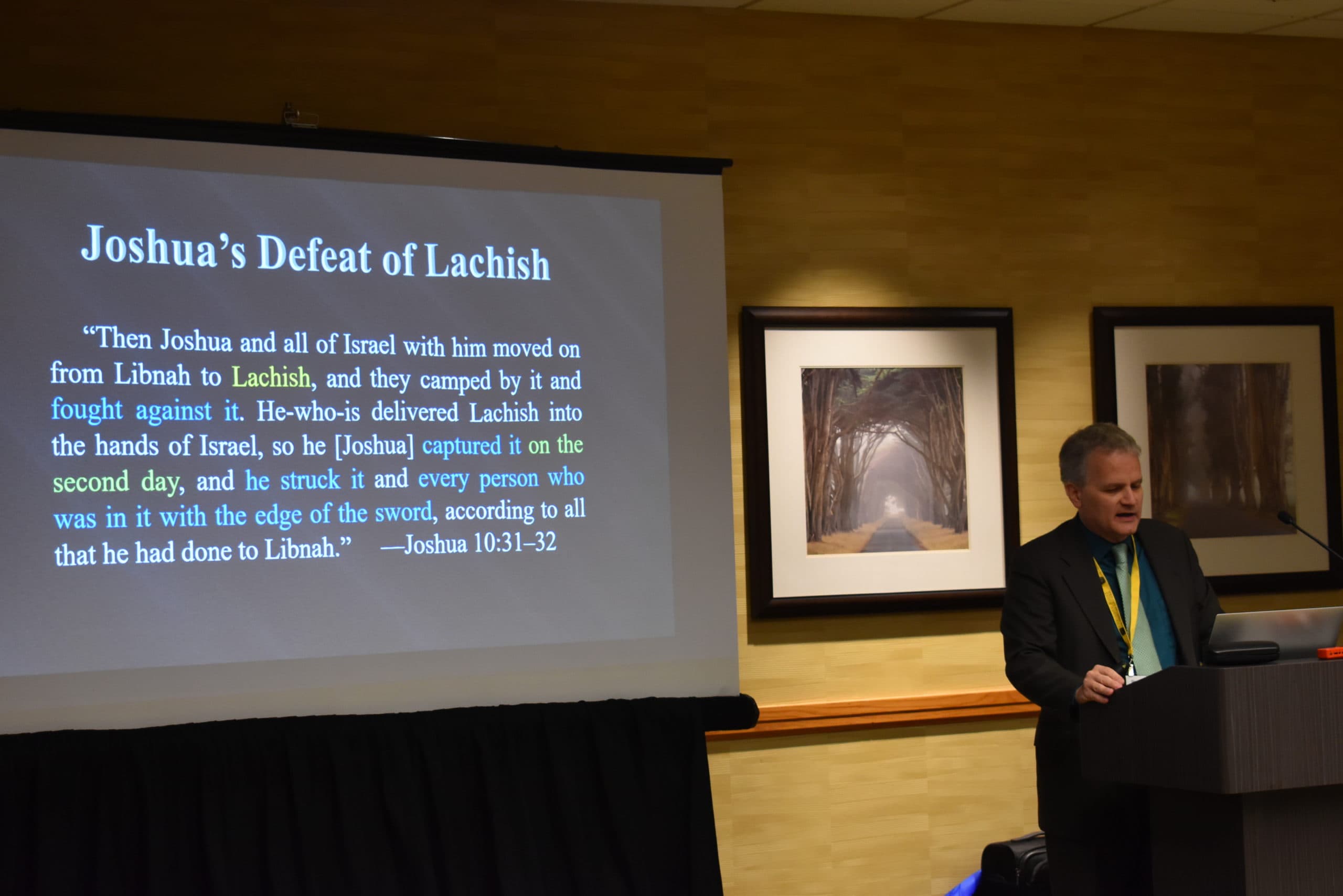
An ancient Hebrew inscription found in a milk bowl fragment in the Canaanite ruins of Lachish can shed light about the life of the area in the time of the biblical Joshua and the judges, according to Brookes Bible College professor Douglas Petrovich. It also would confirm the existence and use of early alphabetic writing at that time, providing a “missing link” for scholars who doubted that writing was viable or known.
Petrovich, who specializes in Ancient Near Eastern history, archaeology, and epigraphy, set out to share these findings during a presentation at the 2022 Evangelical Theological Society meeting in Denver, Colorado, United States, on November 15. He explained the particulars of the discovery, his analysis of the inscription, and its significance for those who believe in the biblical account.
What the Bible Says
Joshua 10 succinctly tells the story of the conquest of Lachish. It reads, “Then Joshua passed from Libnah, and all Israel with him, to Lachish; and they encamped against it and fought against it. And the Lord delivered Lachish into the hand of Israel, who took it on the second day, and struck it and all the people who were in it with the edge of the sword, according to all that he had done to Libnah” (verses 31, 32).
According to Petrovich, Lachish’s population was about 10,000 residents, and it was the second largest city in Canaan after Hazor. This is the reason the Bible emphasizes that Israel took Lachish “on the second day,” since conquering the city required additional effort, he explained.
Lachish’s Ceramics
Petrovich explained that Lachish’s pottery at that time (1560-1406 BCE) was extremely limited in its types. The two most important forms of pottery are Chocolate-on-White and Cypriote Bichrome Ware. “Chocolate-on-White Ware was wheel-made, white-slipped, densely burnished, then decorated with geometric patterns in hues of chocolate and reddish brown,” Petrovich said. “White Slip I Ware was discovered in pits outside of Lachish’s Fosse Temple I.”
Excavations have so far revealed some of the city wall, fragmentary walls and floors, and domestic and pillared buildings from various eras. The teams have also excavated several temples, some of them outside the city wall. Inside the Fosse Temple I, archaeologists discovered several examples of ceramic repertoire, including the type known as Cypriote White Slip II milk bowls.
In this case, the importance of the piece discovered is greater because it is stratified, which means it reveals its original archaeological context. This allows stratigraphers to determine a much more accurate date of the piece and particulars surrounding their findings.
Dating and Translation
Petrovich provided a detailed explanation of the elements that help experts to give an approximate date of the milk bowl fragment, or ostracon, in the 15th century BCE. By using a variety of methods, including the analysis of organic materials in burnt layers, experts have dated the ostracon in year ranges of 1435-1405 or 1425-1395 BCE. This “fits with a destruction in 1406 BC,” Petrovich said.
Experts believe that in Bible chronology, 1406 BCE was the year in which the Israelites crossed the Jordan, destroyed Jericho, established a coalition with the Gibeonites, and destroyed several other Canaanites cities, including Lachish.
As a well-known epigrapher, Petrovich has devoted many years of his professional life to reading inscriptions. In the case of the Lachish milk bowl fragment, he said, “The letters fit exactly as you would expect as an epigrapher.” It has led him to conclude that the words include, from top to bottom, “servant,” “over,” and “honey.” That is to say, the fragment probably belonged to or was used by a servant in charge of the honey.
The term “honey” is key to learning more about the context of the inscription, Petrovich said. “The Hebrew word for ‘honey’ is unique to the Hebrew language,” he explained. “No other Semitic languages use the npt triconsonantal root for honey.… As a result of the linguistic evidence, this inscription cannot have been composed in any Semitic language except Hebrew.… [It] is a distinctively Hebrew inscription.”
Suggested Reconstruction of Events
According to Petrovich, Joshua could have assigned titles to various Israelites such as “servant in charge of the honey” by the time the Israelite campaign in Canaan commenced. The city wall at Lachish came down at various points on day two.
After the wall came down, Israelites warriors advanced into the city and killed its inhabitants. “On his way out of the city, the servant in charge of honey either purposely or accidentally dropped his ostracon atop the burnt debris,” Petrovich said. “His occupational business card reflects God’s pre-conquest statement that the Israelites would find Canaan to be a land flowing with milk and honey [Deut. 31:20], as this proud honey-keeper painted his title on the inside of a potsherd from a ceramic milk bowl.”
Revealing Discoveries
The inscription on the milk bowl fragment is just one of the latest discoveries that shed additional light on the life and times described by some of the books of the Old Testament, Petrovich said. Among them, he mentioned the ivory comb from Lachish discovered in a pit from 587 BCE, which has been dated to the 17th century BCE (even though, Petrovich said, “I am convinced it does not belong to that period.”)
Petrovich also mentioned a Jerusalem curse inscription from the Gihon spring from the period of the judges, a monumental inscription from Hezekiah’s reign (“the first inscription about an Israelite king”), and a curse tablet from Mount Ebal where the covenant name of God is named.
Now, the inscription on the milk bowl fragment adds to increasing discoveries about the early life of Israel in Canaan, Petrovich said, and the extent the Hebrew alphabet was already used.